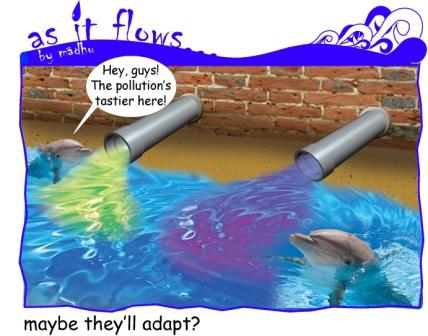Rivers
Study of soil moisture movement and recharge to groundwater using tritium tagging techniques in Saharanpur - A research report by National Institute of Hydrology
Posted on 24 Jul, 2010 10:05 AMThe present study aims to estimate the soil moisture movement and recharge to groundwater in Saharanpur due to monsoon rains through the unsaturated porous media in case of cultivated and uncultivated fields. Artificial radioisotope was injected at two uncultivated and five cultivated sites before the onset of monsoon and soil samples were collected from the injection points after the rainy season.
Hydrogeological and geochemical studies of groundwater flow in Suddagedda basin – A research report by National Institute of Hydrology
Posted on 24 Jul, 2010 12:18 AMThe report presents a hydrogeological and geochemical study of groundwater flow for the Suddagedda basin of Andhra Pradesh. Planning of water resources development projects calls for an understanding and analysis of the hydrological characteristics of the region. The hydrogeology and geochemistry of the basin needs to be investigated particularly for a groundwater resources development project.
Relevance of Meltwater in River Basin Hydrology
Posted on 23 Jul, 2010 10:53 PMA peer paper in Science Magazine focuses on the core of a riverine system, the upstream basin, and its impact on the entire river basin.
Regional model for annual runoff estimation - A research report by National Institute of Hydrology
Posted on 23 Jul, 2010 10:40 PMThe report presents a seasonal rainfall-runoff model developed for the Saurashtra region as well as parts of Narmada river basin. The successful planning and implementation of water resources projects require reliable data on volumetric runoff. It is not feasible to have discharge stations in all the river basins of interest given resource constraints. Therefore, regional rainfall-runoff models are preferred. The utility of such models can be improved if rainfall-runoff models for different regions are developed using data specific to the regions.
Proposing a National River Authority of India (NRAI)
Posted on 23 Jul, 2010 04:29 PMIntervening at the urgency of the water situation of the country and need in larger interest of the people and nation from political, legal, social, administrative, commerce,trade,cultural, world tourism angles, apart from agricultural and drinking water angle; annual devastation by floods,and loss by drought. One single Authority, with P.M. as Chairman may hopefully bring expected and good results in river management; riverine rejuvenation - National River Authority of India
Here is a draft proposal for such an authority to be created.
We are looking for collaborations on making this a reality.
Please post your comments.
Evaluation of groundwater table and quality in Krishna delta of Andhra Pradesh – A research report by National Institute of Hydrology
Posted on 22 Jul, 2010 07:45 AMThe report attempts to analyze the shallow groundwater table and water quality data for about 20 years pertaining to the Krishna delta. The trend analysis of groundwater level data of shallow wells indicates that in the upper part of the delta, the groundwater table moved up during the period 1979 to 1999. This may be due to the dense canal network in the delta and increase in irrigated area over a period of time.
Prof G.D. Agrawal resumes fast unto death to save the Ganga, Swami Avimukteshwaranand and others to join in support
Posted on 21 Jul, 2010 11:10 AMForwarded to the Portal by: Ayan Biswas
Image and News Courtesy:
Shankracharya designate Swami Avimukteshwaranand ji presided over an emergency meeting organized by Manushi Sangathan, Ganga Ahvaan and Ganga Yamuna Jal Biradri to express our strong protest against the patently illegal decision of the Group of Ministers giving clearance to the Loharinag-Pala dam on the Ganga River. The following expert members of the NGRBA also participated in the meeting to express their strong protest having been kept in the dark about the appointment of the GoM which has passed a virtual death sentence on the most sacred river of India: Rashid Hyatt Siddiqui, Rajendra Singh, Rama Raota and Ravi Chopra.
Artificial recharging of an unconfined aquifer with an injection well in Ghataprabha sub-basin– A research report by National Institute of Hydrology
Posted on 21 Jul, 2010 08:47 AMThe report deals with the artificial recharging of an unconfined aquifer with injection well in the Hukkeri taluka in Ghataprabha sub-basin of Krishna river. The Ghataprabha sub-basin of Krishna like most river basins of peninsular India has been facing groundwater development problems varying in nature and severity. It has got a wide spectrum of issues such as cases of failure of wells at several places on the one hand, while some areas becoming unfertile due to waterlogging.
Environment flows - Continuing the discussion
Posted on 21 Jul, 2010 12:41 AM
Watershed prioritization of Ukai dam catchment in Gujarat using remote sensing and GIS – A research report by National Institute of Hydrology
Posted on 20 Jul, 2010 08:29 PMIn the present study, watershed prioritization of the catchment immediately upstream of the Ukai reservoir has been carried out using remote sensing technique. The Watershed Response Model (WRM) has been used for this purpose. This model utilizes the Normalized Difference Vegetation Index (NDVI) and the Soil Brightness Index (SBI), the two important parameters responsible for soil erosion.




